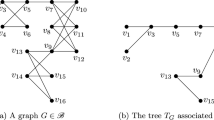Abstract
An order-m Latin square is a factor pair Latin square if, for each ordered pair (a, b) of positive integers satisfying \(ab=m\), there is no repetition of symbols in any \(a\times b\) tiling region. If p is prime and n is a natural number, we introduce a new characterization of order-\(p^n\) linear factor pair Latin squares. We use this characterization to show that the Latin squares constructed by Mariot et al. (Des Codes Cryptogr 88:391-411, 2020) corresponding to \({{\mathbb {F}}}_q\)- linear bipermutive cellular automata are linear factor pair Latin squares when q is prime. These linear factor pair Latin squares are called cellular factor pair Latin squares. We then apply the results and methods of Mariot et al. (2020) to construct maximally sized families of pairwise mutually orthogonal cellular factor pair Latin squares of order \(p^n\), and likewise for diagonal cellular factor pair Latin squares of order \(p^n\). The size of each of these two families is asymptotic to \(p^n/n\).



Similar content being viewed by others
References
Bailey R., Cameron P., Connelly R.: Sudoku, gerechte designs, resolutions, affine space, spreads, reguli, and Hamming codes. Am. Math. Mon. 115(5), 383–404 (2008).
Bremigan R., Lorch J.: Mutually orthogonal rectangular gerechte designs. Linear Algebra Appl. 497, 44–61 (2016).
Carrigan B., Hammer J., Lorch J.: A regional Kronecker product and multiple-pair Latin squares. Discret. Math. 343(3), 111762 (2020).
Colbourn C., Dinitz J. (eds.): The Handbook of Combinatorial Designs, 2nd edn CRC Press, Boca Raton (2007).
Dénes J., Keedwell A.D.: Latin Squares and Their Applications, 2nd edn North Holland, Amsterdam (2015).
Dummit D., Foote R.: Abstract Algebra, 2nd edn Prentice Hall, Upper Saddle River (1999).
Ethier J., Mullen G.: Sets of mutually orthogonal frequency squares. Des. Codes Cryptogr. 87, 57–65 (2019).
Gadouleau M., Mariot L., Picek S.: Bent functions in the partial spread class generated by linear recurring sequences. Des. Codes Cryptogr. 91, 63–82 (2023).
Hammer J., Hoffman D.: Factor pair Latin Squares. Australas. J. Comb. 69, 41–57 (2017).
Hammer J., Lorch J.: Orthogonal factor-pair Latin squares of prime-power order. J. Comb. Des. 27(9), 552–561 (2019).
Keedwell A.D.: On sudoku squares. Bull. Inst. Comb. Appl. 50, 52–60 (2007).
Keedwell A.D.: Constructions of complete sets of orthogonal diagonal Sudoku squares. Australas. J. Comb. 47, 227–238 (2010).
Keedwell A.D.: A short note regarding the existence of complete sets of orthogonal diagonal Sudoku squares. Australas. J. Comb. 51, 271–273 (2011).
Lidl R., Niederreiter H.: Finite fields. In: Encyclopedia of Mathematics and Its Applications, vol. 20, 2nd edn. Cambridge University Press, Cambridge (1997).
Mariot L., Gadouleau M., Formenti E., Leporati A.: Mutually orthogonal Latin squares based on cellular automata. Des. Codes Cryptogr. 88, 391–411 (2020).
McEliece R.: Finite Fields for Computer Scientists and Engineers. Kluwer Academic Publishers, Boston (1987).
Author information
Authors and Affiliations
Corresponding author
Additional information
Communicated by C. J. Colbourn.
Publisher's Note
Springer Nature remains neutral with regard to jurisdictional claims in published maps and institutional affiliations.
Rights and permissions
Springer Nature or its licensor (e.g. a society or other partner) holds exclusive rights to this article under a publishing agreement with the author(s) or other rightsholder(s); author self-archiving of the accepted manuscript version of this article is solely governed by the terms of such publishing agreement and applicable law.
About this article
Cite this article
Hammer, J., Lorch, J. Diagonal cellular factor pair Latin squares. Des. Codes Cryptogr. 91, 2309–2322 (2023). https://doi.org/10.1007/s10623-023-01200-0
Received:
Revised:
Accepted:
Published:
Issue Date:
DOI: https://doi.org/10.1007/s10623-023-01200-0




